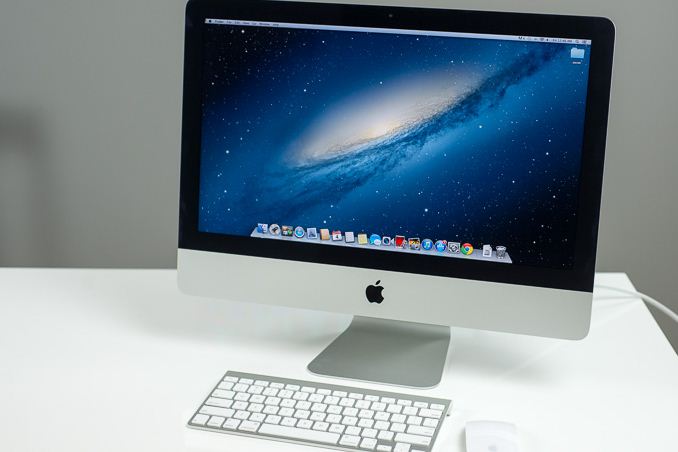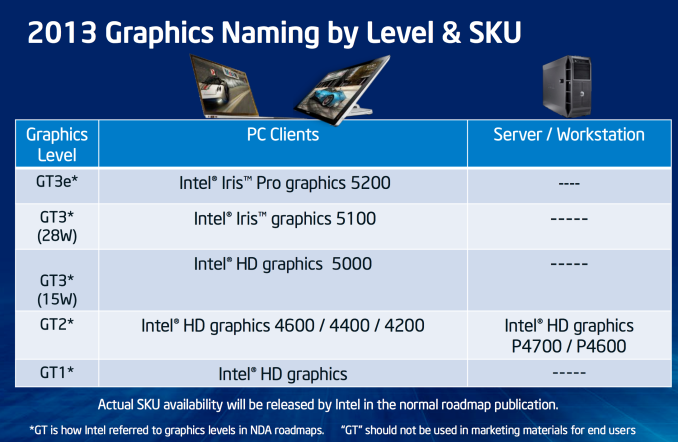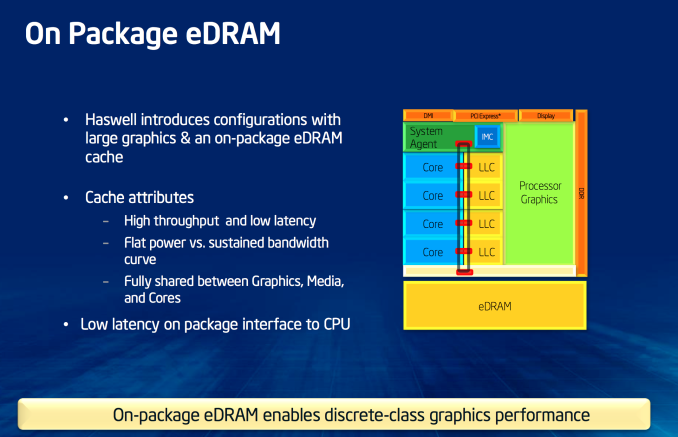21.5-inch iMac (Late 2013) Review: Iris Pro Driving an Accurate Display
by Anand Lal Shimpi on October 7, 2013 3:28 AM EST
I have a confession to make. For the past year I’ve been using a 27-inch iMac as my primary workstation. I always said that if I had a less mobile lifestyle the iMac is probably the machine I’d end up with (that was prior to the announcement of the new Mac Pro of course). This past year has been the most insane in terms of travel, so it wasn’t a lack of mobility that kept me on the iMac but rather a desire to test Apple’s new Fusion Drive over the long haul.
It’s entirely possible to mask the overwhelmingly bad experience of a hard drive in a high performance machine by only sampling at the beginning of the journey. When the OS is a clean install, the drive is mostly empty and thus operating at its peak performance. Obviously Apple’s Fusion Drive is designed to mitigate the inevitable performance degradation, and my initial take on it after about a month of use was very good - but would it last?
I’m happy to report that it actually did. So today’s confession is really a two-parter: I’ve been using an iMac for the past year, and I’ve been using a hard drive as a part of my primary storage for the past year. Yeesh, I never thought I’d do either of those things.
| Apple 2013 iMac | |||||||||
| Configuration | 21.5-inch iMac | 21.5-inch Upgraded iMac | 27-inch iMac | 27-inch Upgraded iMac | |||||
| Display | 21.5-inch 1920 x 1080 | 21.5-inch 1920 x 1080 | 27-inch 2560 x 1440 | 27-inch 2560 x 1440 | |||||
| CPU (Base/Turbo) | Intel Core i5-4570R (2.7GHz/3.2GHz) | Intel Core i5-4570S (2.9GHz/3.6GHz) | Intel Core i5-4570 (3.2GHz/3.6GHz) | Intel Core i5-4670 (3.4/3.8GHz) | |||||
| GPU | Intel Iris Pro 5200 | NVIDIA GeForce GT 750M (1GB GDDR5) | NVIDIA GeForce GT 755M (1GB GDDR5) | NVIDIA GeForce GTX 775M (2GB GDDR5) | |||||
| RAM | 8GB DDR3-1600 | 8GB DDR3-1600 | 8GB DDR3-1600 |
8GB DDR3-1600 |
|||||
| Storage | 1TB 5400RPM | 1TB 5400RPM | 1TB 7200RPM | 1TB 7200RPM | |||||
| WiFi | 802.11ac | ||||||||
| I/O | 4 x USB 3.0, 2 x Thunderbolt, 1 x GigE, SDXC reader, headphone jack | ||||||||
| Starting Price | $1299 | $1499 | $1799 | $1999 | |||||
This year the iMacs get incrementally better. Displays and resolutions are the same, but silicon options are a bit quicker, 802.11ac is on deck and the SSDs all move to PCIe (including Fusion Drive). As tempted as I was to begin my first look at the 2013 iMac evaluating the impact of going to faster storage, it was the entry-level model that grabbed my attention first because of a little piece of silicon we’ve come to know as Crystalwell.
The CPU: Haswell with an Optional Crystalwell
The entry level 21.5-inch iMac is one of the most affordable options in Apple’s lineup. At $1499 Apple will typically sell you a dual-core notebook of some sort, but here you get no less than a quad-core, 65W Core i5-4570R. That’s four cores running at 2.7GHz, and capable of hitting up to 3.2GHz. In practice I pretty much always saw the cores running at 3.0GHz regardless of workload. I’d see some excursions up at 3.1GHz but for the most part you’re effectively buying a 3GHz Haswell system.
The R at the end of the SKU connotes something very special. Not only do you get Intel’s fastest GPU configuration (40 EUs running at up to 1.15GHz), but you also get 128MB of on-package eDRAM. The combination of the two gives you a new brand: Intel’s Iris Pro 5200.
The Iris Pro 5200 is a GPU configuration option I expect to see on the 15-inch MacBook Pro with Retina Display, and its presence on the iMac tells us how it’ll be done. In last year’s iMacs, Apple picked from a selection of NVIDIA discrete GPUs. This year, the entry level 21.5-inch model gets Iris Pro 5200 while the rest feature updated NVIDIA Kepler discrete GPUs. It’s the same bifurcation that I expect to find on the 15-inch MacBook Pro with Retina Display. As we found in our preview of Intel’s Iris Pro 5200, in its fastest implementation the GPU isn’t enough to outperform NVIDIA’s GeForce GT 650M (found in the 2012 15-inch rMBP). Apple’s engineers aren’t particularly fond of performance regressions, so the NVIDIA GPUs stick around for those who need them, and for the first time we get a truly decent integrated option from Intel.

Most PC OEMs appear to have gone the opposite route - choosing NVIDIA’s low-end discrete graphics over Intel’s Iris Pro. The two end up being fairly similar in cost (with Intel getting the slight edge it seems). With NVIDIA you can get better performance, while Intel should deliver somewhat lower power consumption and an obvious reduction in board area. I suspect Iris Pro probably came in a bit slower than even Apple expected, but given that Apple asked Intel to build the thing it probably felt a bit compelled to use it somewhere. Plus there’s the whole believing in the strategy aspect of all of this. If Apple could shift most of its designs exclusively to processor graphics, it would actually be able to realize board and power savings which would have an impact on industrial design. We’re just not there yet. Whether we ever get there depends on just how aggressive Intel is on the graphics front.
I already went through what the 128MB eDRAM (codename Crystalwell) gets you, but in short that massive on-package memory acts as a L4 cache for both the CPU and GPU. You get 50GB/s of bandwidth in both directions, and access latency somewhere between L3 cache and main memory requests.

OS X doesn’t seem to acknowledge Crystalwell’s presence, but it’s definitely there and operational (you can tell by looking at the GPU performance results). Some very specific workloads can benefit handsomely from the large eDRAM. At boot I suspect key parts of the OS are probably cached on-package as well, something that’ll have big implications for power usage in mobile. Unfortunately my review sample came with a hard drive, and these new iMacs aren’t super easy to break into (not to mention that Apple frowns upon that sort of behavior with their review samples), which hampered the user experience. OS X continues to do a good job of keeping things cached in memory, and the iMac’s 8GB default configuration helps there tremendously. Whenever I was working with data and apps in memory, the system felt quite snappy. I’ll get to the benchmarks in a moment.
The non-gaming experience with Iris Pro under OS X seemed fine. I noticed a graphical glitch under Safari in 10.8.5 (I saw tearing while scrolling down a long list of iCloud tabs) but otherwise everything else looked good.
| iMac (Late 2013) CPU Options | ||||||
| 21.5-inch | 27-inch | |||||
| Base | Upgraded | Optional | Base | Upgraded | Optional | |
| Intel CPU | i5-4570R | i5-4570S | i7-4770S | i5-4570 | i5-4670 | i7-4771 |
| Cores / Threads | 4 / 4 | 4 / 4 | 4 / 8 | 4 / 4 | 4 / 4 | 4 / 8 |
| Base Clock | 2.7GHz | 2.9GHz | 3.1GHz | 3.2GHz | 3.4GHz | 3.5GHz |
| Max Turbo | 3.2GHz | 3.6GHz | 3.9GHz | 3.6GHz | 3.8GHz | 3.9GHz |
| L3 Cache | 4MB | 6MB | 8MB | 6MB | 6MB | 8MB |
| TDP | 65W | 65W | 65W | 65W | 84W | 84W |
| VT-x / VT-d | Y / Y | Y / Y | Y / Y | Y / Y | Y / Y | Y / Y |
| TSX-NI | N | Y | Y | Y | Y | Y |
In typical Intel fashion, you get nothing for free. The 128MB of eDRAM comes at the expense of a smaller L3 cache, in this case 4MB shared by all four cores (and the GPU). Note that this tradeoff also exists on the higher end Core i7 R-series SKU, but 6MB of L3 is somehow less bothersome than 4MB. This is the lowest core:L3 cache ratio of any modern Intel Core series processor. The 128MB eDRAM likely more than makes up for this reduction, and I do wonder if this isn’t a sign of things to come from Intel. A shift towards smaller, even lower latency L3 caches might make sense if you’ve got a massive eDRAM array backing it all up.












127 Comments
View All Comments
Calista - Tuesday, October 8, 2013 - link
They have become pretty inexpensive nowadays. A Dell 21" Dell Ultrasharp IPS-screen is only 40-50 USD more expensive than the cheapest TN-panel. Still don't think people are fair when complaining about the cost of the iMac. It's quiet, it looks good, it holds a great resale value. A lot of people would think twice about dropping $500 a month of their car, why not spend a few extra quid on a computer? Back in the days a computer was expensive, now it's so cheap it's almost silly.repoman27 - Monday, October 7, 2013 - link
Not that I'd buy a base model 21.5-inch iMac, but I think most consumers could care less about their CPU and GPU specs and are looking more at the overall package. For most office desk jockeys, school computer labs, customer use / internet kiosks, parents, etc., the iMac probably makes more sense than a custom built overclocked gaming rig.It also depends on how much you value what you get in said package. The i5-4570R is essentially an i5-4430S with Iris Pro 5200, so it's likely a $240-270 part. Then there's the rather well calibrated 1920x1080 IPS panel which would run another $150 or so. The keyboard and mouse that are included have a combined retail price of $138. Then there's the 3x3:3 802.11ac Wi-Fi plus Bluetooth 4.0, Broadcom GbE NIC and SDXC UHS-I card reader, Thunderbolt, 720p camera, dual microphones, built-in amp and stereo speakers, plus whatever value you put on OS X and the bundled iLife suite.
Flunk - Monday, October 7, 2013 - link
Screen, form-factor, OS. Performance isn't the number one concern for many people.Dug - Monday, October 7, 2013 - link
Someone that wants everything built in that doesn't sound or look like a piece of crap.Add up everything that is included and it's not that expensive. Especially when you consider the cpu is quad core (almost all laptop i5's are dual core), 802.11ac, dual mics, webcam, speakers, bluetooth, sdxc, thunderbolt, wireless keyboard and trackpad, a calibrated IPS monitor, and the best part is no noise and only one cable with no power brick. Try and do that with any diy build and tell me how much it is.
KoolAidMan1 - Monday, October 7, 2013 - link
IPS screens aren't cheap, nor are AIO designs. Dell, HP, and Lenovo can't get lower prices when they try to compete in specs or display quality either.A $500 laptop isn't going to have a good display, keyboard, or trackpad either, and resale value is going to be nothing. Comparing a trash laptop to something with much higher quality components that holds value over time doesn't make sense.
robsparko - Tuesday, October 8, 2013 - link
This argument is getting old and inaccurate. People don't always want laptops. Additionally, bottom of the barrel hardware has a very short life span. Sometimes, it is nice to have a well integrated AIO without cables running everywhere. Sure, not everyone wants a computer that will last 3+ years and that is perfectly fine.But, just for fun, here's some pricing from NewEgg parts I believe would be of similar quality to an iMac. Yes, you can find cheaper cases/PSU/etc, but an iMac isn't built using the cheapest components. Likewise, feel free to buy a Dell! But, to call people who buy an iMac ignorant/ out of the mind/ etc is just proving a lack of insight into the situation and market pricing.
250 i5 cpu w/ IRIS (good luck finding it! NewEgg's uses HD4600)
150 mobo
75 case
75 psu
235 IPS 21.5" lcd
65 hdd
50 webcam w/ mic
75 ram
140 windows
65 wireless kb/mouse
35 speakers
?? shipping/tax
?? Time to built
----------------
1215 Total + extra
Calista - Tuesday, October 8, 2013 - link
What you did is a game created to let Apple look good. I made a similar list with parts from Newegg. It was only $1150 but included a Shuttle case, a 27" IPS-display from Dell, a 240 GB Intel SSD and 16 GB of RAM. And Windows 8 Retail obviously. A similar config but with a 21" display from Apple was $1870. The 27" iMac with similar configuration was almost $2400, i.e. twice as expensive as the PC.web2dot0 - Saturday, October 12, 2013 - link
Let me guess, your parts are the same part quality as Apple's ? :)The case isn't worth anything, a calibrated monitor isn't worth anything, AIO isn't worth anything, fusion drive isn't worth anything, .... That's cool.
I can play that game too jackass
foolio5 - Monday, October 14, 2013 - link
Are you really equating an inflated price to higher quality parts? Quick tell me the difference between Kingston and Samsung Ram! How do you know his PSU isn't a Seasonic? What exactly is the brand HDD Apple uses? I heard this all the time about quality parts when everything Apple uses is Samsung or Foxconn. Yes Foxconn... the epitome of quality OEMs!You are adding a lot of money for having an AIO. He is using a Dell 27" IPS, that should clue you into the fact that it is an Ultrasharp which is calibrated, also hes using an SSD so again tell me how a Hybrid beats out an SSD.
Lastly, are you 12 or something. Your name calling is immature.
abazigal - Tuesday, October 8, 2013 - link
I would (if I didn't already own a 2011 27" imac), which I found to be worth every cent.It makes perfect financial sense when you realise that you are not so much buying a computer, as you are getting an integrated solution that's ready to use right out of the box. I find that Macs come with excellent functionality without me having to spend much time setting it up.
Already, it comes preloaded with the excellent iLife suite, a great pdf annotation reader (preview), a stable OS that continues to run smoothly 2 years on without me needing to do anything to maintain it, entry to the Apple ecosystem, and access to fairly inexpensive Mac software.
Then, there is the good aftercare service. Once, my Imac developed screen issues. I made a call to the service centre. 20 minutes later, an appointment was made. They came down to my house the next day, brought it back for servicing, and delivered it back to my house 2 days later. Problem solved with minimal effort or stress on my part.
So in the end, the extra that I am paying is well worth it for the promise of a seamless and hassle-free computing experience. Which I value more than if I were to simply build a desktop using parts sourced individually (and then having to deal with all the troubleshooting on my own subsequently).